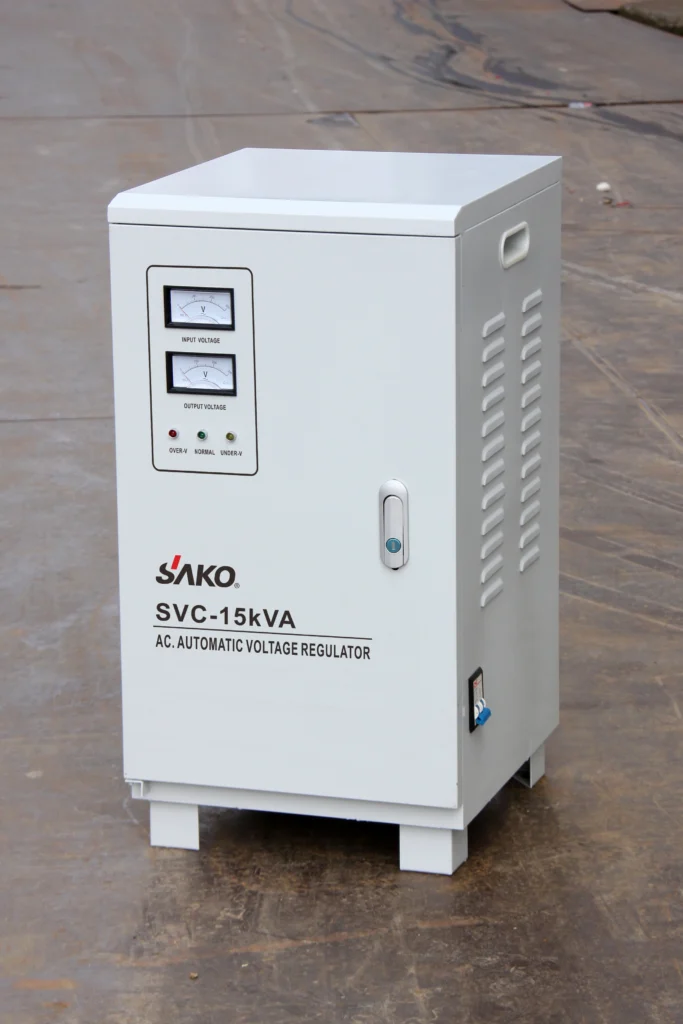In our daily life and work, a stable power supply is essential. The single-phase voltage stabilizer is the key device to ensure a stable single-phase power supply.
I. Working Principle of Single-Phase Voltage Stabilizer
A single-phase voltage stabilizer works by adjusting the taps of an autotransformer to change the output voltage, thereby compensating for input voltage fluctuations. When the input voltage increases, the stabilizer automatically lowers the output voltage; when the input voltage drops, the stabilizer increases the output voltage to ensure that the output voltage remains within a relatively stable range.
II. Importance of Single-Phase Voltage Stabilizer
- Protect Electrical Equipment
- Unstable voltage can cause serious damage to electrical equipment, such as shortening its lifespan and increasing the likelihood of malfunctions. The single-phase voltage stabilizer provides stable voltage to protect equipment from voltage fluctuations.
- For precision electronic devices that require stable voltage, such as computers and medical equipment, a single-phase voltage stabilizer is indispensable.
- Improve Power Quality
- Voltage fluctuations not only affect the normal operation of electrical equipment but also reduce power quality. The single-phase voltage stabilizer effectively reduces voltage fluctuations, improves power quality, and provides users with a more stable and reliable power supply.
- Energy Savings
- When voltage is unstable, electrical equipment often consumes more energy to maintain normal operation. A single-phase voltage stabilizer allows devices to operate under stable voltage, reducing energy consumption and saving power.
III. Types of Single-Phase Voltage Stabilizers

- Contact-Type Voltage Stabilizer
- A contact-type voltage stabilizer adjusts the output voltage by changing the contact position of the transformer windings. It is simple in structure, low-cost, and highly reliable, but its regulation accuracy is relatively low.
- Induction-Type Voltage Stabilizer
- An induction-type voltage stabilizer adjusts the output voltage by changing the induced electromotive force of the transformer windings. It features high adjustment accuracy, fast response, and no mechanical contacts, but it is relatively more expensive.
- Electronic Voltage Stabilizer
- An electronic voltage stabilizer uses electronic circuits to adjust the output voltage. It has high regulation accuracy, fast response, small size, and lightweight, but it is more expensive and has higher environmental requirements.
IV. How to Choose a Single-Phase Voltage Stabilizer
- Determine Load Power
- When selecting a single-phase voltage stabilizer, first determine the load power. The rated power of the stabilizer should be greater than the power of the load to ensure the stabilizer can work properly.
- Consider Input Voltage Range
- Since grid voltage may vary in different regions, consider the input voltage range when choosing a stabilizer. The input voltage range should cover the voltage fluctuations in the local power grid.
- Pay Attention to Output Voltage Accuracy
- For devices with strict voltage requirements, the output voltage accuracy is an important factor. Generally, the higher the output voltage accuracy, the better the stabilizer's performance.
- Consider Reliability and Stability
- The reliability and stability of the stabilizer are directly related to the normal operation and lifespan of electrical equipment. Choose products with a high brand reputation, reliable quality, and good after-sales service.
V. Precautions for Using a Single-Phase Voltage Stabilizer
- Installation Location
- The stabilizer should be installed in a well-ventilated, dry area, free from corrosive gases. Avoid installing it in direct sunlight, damp, high-temperature, or low-temperature environments.
- Correct Wiring
- Ensure the wiring is correct when installing the stabilizer. The wires on the input and output terminals should be firmly connected to avoid poor contact or short circuits.
- Regular Maintenance
- The stabilizer requires regular maintenance, such as cleaning the casing, checking for loose wires, and testing if the output voltage is stable. If issues are found, repair or replace them promptly.
In conclusion, the single-phase voltage stabilizer is a vital device for ensuring a stable single-phase power supply. When choosing and using a stabilizer, select one based on actual needs, and pay attention to the installation location, correct wiring, and regular maintenance to ensure it works properly and provides stable power for your electrical equipment.
